

Towards Data Science. Kaggle: Your Machine Learning and Data Science Community. Data Science - Medium. Analytics Vidhya - Learn Machine learning, artificial intelligence, business analytics, data science, big data, data visualizations tools and techniques. Datanami: Big Data, Big Analytics, Big Insights. About - Project Euler. Quora. The One-Stop Shop for Big Data. Today, I’m going to explain in plain English the top 10 most influential data mining algorithms as voted on by 3 separate panels in this survey paper.
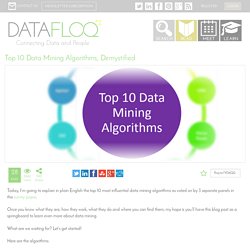
Once you know what they are, how they work, what they do and where you can find them, my hope is you’ll have this blog post as a springboard to learn even more about data mining. What are we waiting for? Let’s get started! Here are the algorithms: 1. What does it do? C4.5 constructs a classifier in the form of a decision tree. DataTau. Information is Beautiful Awards. DataKind. Data Science Central.
Big Data and data mining.
AI. Courses. Data Science. BI, Big Data & Analytic. Portail données ouvertes. Pattern Discovery in Data Mining from Coursera. Yaser S. Abu-Mostafa. A special UC Berkeley iSchool course. A Practical Intro to Data Science — Zipfian Academy - Data Science Bootcamp. Are you a interested in taking a course with us?
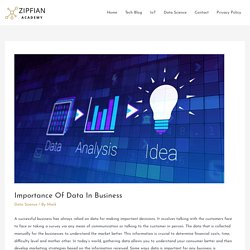
Learn more on our programs page or contact us. There are plenty of articles and discussions on the web about what data science is, what qualities define a data scientist, how to nurture them, and how you should position yourself to be a competitive applicant. There are far fewer resources out there about the steps to take in order to obtain the skills necessary to practice this elusive discipline.
Here we will provide a collection of freely accessible materials and content to jumpstart your understanding of the theory and tools of Data Science. At Zipfian Academy, we believe that everyone learns at different paces and in different ways. How to Become a Data Scientist.
Big Data Companies to look for. Big Data Explorer Web App - Learn About Big Data. What should I study or learn if I want to be a data analyst? Random forest. The selection of a random subset of features is an example of the random subspace method, which, in Ho's formulation, is a way to implement classification proposed by Eugene Kleinberg.[6] History[edit] The early development of random forests was influenced by the work of Amit and Geman[5] which introduced the idea of searching over a random subset of the available decisions when splitting a node, in the context of growing a single tree.
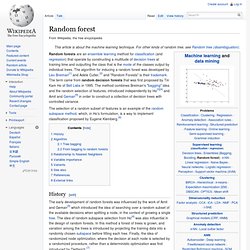
The idea of random subspace selection from Ho[4] was also influential in the design of random forests. In this method a forest of trees is grown, and variation among the trees is introduced by projecting the training data into a randomly chosen subspace before fitting each tree. Finally, the idea of randomized node optimization, where the decision at each node is selected by a randomized procedure, rather than a deterministic optimization was first introduced by Dietterich.[7] Algorithm[edit] Tree bagging[edit] In the above algorithm, B is a free parameter. Python (programming language): How can I learn to program in Python? How do I become a data scientist? Heat map. Heat map generated from DNA microarray data reflecting gene expression values in several conditions Heat maps originated in 2D displays of the values in a data matrix.
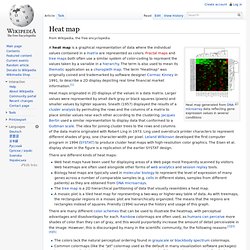
Larger values were represented by small dark gray or black squares (pixels) and smaller values by lighter squares. Sneath (1957) displayed the results of a cluster analysis by permuting the rows and the columns of a matrix to place similar values near each other according to the clustering. Starting Your Big Data Lab for a POC. In continuation of my previous blog post, “6 Steps to Start Your Big Data Journey,” I want to address here the question “How should you start your big data journey?” What is the Big Data Lab?
Fall 10 Course: Introduction to Data Mining and Analysis. Syllabus (tentative) What's this course about?
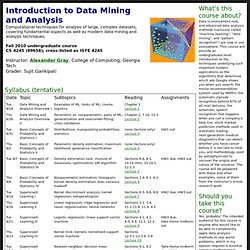
Data is everywhere now, and advanced data analysis methods (variously called "machine learning", "data mining", and "pattern recognition") are now in use everywhere. This course will provide an undergraduate-level introduction to the techniques underlying such important modern applications as the algorithms that determine which ads Google shows you when you search, the movie recommendation system used by Netflix, the automatic zipcode recognition behind 97% of all mail delivery, the automatic speech recognition that happens when you call a company's help line, stock market prediction methods used in automatic trading, next-generation medical diagnostics that can detect whether you have cancer before it is too late to treat you, and methodology used by astrophysicists to uncover the origins and nature of the universe.
The course will be peppered with these and other examples, some of them from the instructor's actual research work. Book. RapidMiner. Predictive Analytics 101. Insight, not hindsight is the essence of predictive analytics. How organizations instrument, capture, create and use data is fundamentally changing the dynamics of work, life and leisure. I strongly believe that we are on the cusp of a multi-year analytics revolution that will transform everything. Using analytics to compete and innovate is a multi-dimensional issue. It ranges from simple (reporting) to complex (prediction). Reporting on what is happening in your business right now is the first step to making smart business decisions. By automatically delivering relevant insights to end-users, managers and even applications, predictive decision solutions aims to reduces the need of business users to understand the ‘how’ and focus on the ‘why.’ Intro To Predictive Analytics Reading List.
Predictive Analytics Is Red Hot Why?
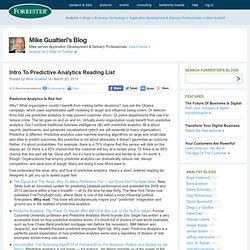
What organization couldn’t benefit from making better decisions? Just ask the Obama campaign, which used sophisticated uplift modeling to target and influence swing voters. Or telecom firms that use predictive analytics to help prevent customer churn. Or police departments that use it to reduce crime. Few understand the what, why, and how of predictive analytics. The Signal And The Noise: Why So Many Predictions Fail — but Some Don’t by Nate Silver. Konstanz Information Miner. Course Offer for 2000-2001 Spring Semester. MIS 542 Data Mining Concepts and Techniques 2013/2014 Fall Instructor: Bertan Badur, Ph.D.

IT Trends 2014 – Accenture Technology Vision. Big Data: A Revolution That Will Transform How We Live, Work, and Think: Viktor Mayer-Schonberger, Kenneth Cukier: 9780544002692: Amazon.com. Big Data Analytics: Disruptive Technologies for Changing the Game: Dr. Arvind Sathi: 9781583473801: Amazon.com. Big Data For Dummies: Judith Hurwitz, Alan Nugent, Fern Halper, Marcia Kaufman: 9781118504222: Amazon.com. Too Big to Ignore: The Business Case for Big Data (Wiley and SAS Business Series): Phil Simon: 9781118638170: Amazon.com. Predictive Analytics: The Power to Predict Who Will Click, Buy, Lie, or Die: Eric Siegel, Thomas H. Davenport: 9781118356852: Amazon.com.
Big data.